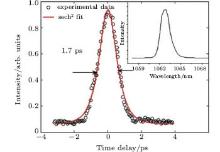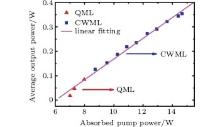Corresponding author. E-mail: jieliu@sdnu.edu.cn
Project supported by the National Natural Science Foundation of China (Grant Nos. 61078032, 61378024, 60938001, and 61078053) and the Science and Technology Development Projects of Shandong Province, China (Grant No. 2013GGX10108).
By using a reflective graphene oxide as saturable absorber, a diode-pumped passively mode-locked Yb3 +:Sc2SiO5 (Yb:SSO) laser has been demonstrated for the first time. Without extra negative dispersion compensation, the minimum pulse duration of 1.7 ps with a repetition rate of 94 MHz was obtained at the central wavelength of 1062.6 nm. The average output power amounts to 355 mW under the absorbed pump power of 15 W. The maximum peak power of the mode-locking laser is up to 2.2 kW, and the single pulse energy is 3.8 nJ.
In recent years, diode pumped passively mode locked solid-state lasers have been intensively investigated because of their advantages of simplicity, compactness, low cost, and high efficiency.[1, 2] The saturable absorber (SA) is a very important modulation element to generate passively mode locked pulses. So far, the semiconductor saturable absorber mirrors (SESAMs), [1, 3, 5] carbon nanotubes (SWNTs)[6, 9] and graphene[10, 14] SAs have been extensively investigated. In addition, some new types of saturable absorbers have been demonstrated as passively mode locked saturable absorbers. For instance, by using the topological insulators (TI) Bi2Se3[15] and molybdenum disulfide (MoS2)[16] as saturable absorbers, the passive mode-locking of an erbium-doped fiber laser and the mode-locking of an ytterbium-doped fiber laser have been demonstrated, respectively.
Graphene, a two-dimensional allotrope of sp2-bonded carbon atoms, has been studied extensively in recent years owing to its remarkable mechanical, [17] thermal, [18] electrical, [19] and optical properties.[20] In addition to the intrinsic advantages of ultrafast recovery time, [21]lower saturation energy fluency[22] and broadband operation, graphene has a zero band gap, [23] which can absorb all photons, ranging from visible wavelengths to terahertz. Hence diode-pumped mode-locked solid-state lasers using graphene as saturable absorbers have been actively reported.[12, 14] Graphene oxide (GO), which served as the precursor for graphene, has also been widely investigated for its own physical and chemical characteristics.[24] On one hand, GO has strong hydrophilicity and water-solubility, both due to the presence of oxygen-containing groups, which offers superior flexibility and processibility. Besides, the technology of manufacturing GO is simpler than that of graphene. Therefore, there is a possibility of mass production of GO. On the other hand, although the oxygen functional groups destroy the gapless linear dispersion of Dirac electrons in graphene and make GO an insulator, GO also possesses a continuous absorbance curve that is almost constant at 1 μ m.[25] It has been demonstrated that graphene oxide also has ultrafast relaxation of hot carriers compared with that of graphene and stronger non-linear saturable absorption than graphene.[24, 26] Based on these characteristics, in Ref. [27], Sobon et al. pointed that GO could be a good candidate material for cost-effective saturable absorbers. Many GO-based pulsed lasers have been reported recently.[28, 31]
Yb:Sc2SiO5(Yb:SSO) is one of the oxyorthosilicate laser crystals, which exhibits exciting advantages of large energy-level splitting, high thermal conductivity, and broad absorption bandwidth. Furthermore, Yb:SSO has the advantage of a negative thermal dispersion index of − 6.3× 10− 6 K− 1, [32] which can partly compensate for the thermal expansion. It is a promising material for passively mode-locked systems. Up to now, mode-locked Yb:SSO lasers have been demonstrated by using SESAMs[5] and carbon nanotubes.[8, 9]
In the present work, using a reflective graphene oxide as the saturable absorber, we are first to demonstrate a passively mode-locked Yb:SSO laser. The laser operated at 1062.6 nm with repetition frequency of 94 MHz. Without extra negative dispersion compensation, the minimum pulse duration of 1.7 ps is obtained. The average output power achieved is 355 mW with the single pulse energy of 3.8 nJ and peak power of 2.2 kW.
A W-type resonator was employed in this experiment as shown schematically in Fig. 1. The Yb:SSO crystal was 3 mm × 3 mm × 2 mm with doping concentration of 5 at%, which was coated for antireflection at lasing wavelength and at the pump wavelength on both faces. By adjusting the temperature, it was pumped by a 977-nm fiber-coupled diode laser with an emission bandwidth of 5 nm. The diode laser pigtail fiber has core-diameter of 400 μ m and N.A. of 0.22. The pump beam was focused on the laser crystal by a couple of convex lens with the pump beam radius of 100 μ m. The laser crystal was wrapped with indium foil and then mounted on a water-cooled copper crystal holder with the cooling water temperature set at 14 ° C. To suppress high-order transverse modes, the pump beam mode size was slightly smaller than the laser mode size inside the gain medium. Laser cavity consisted of five mirrors. The input mirror M1 was a flat mirror, which was antireflection coated at 977 nm and high-reflection coated at 1030 nm– 1080 nm. M2 and M3 were high-reflection mirrors coated at 1030 nm– 1080 nm with radii of curvature of 200 and 800 mm, respectively. An output coupler (OC) with transmission of 1% and radius of curvature of 80 mm was selected for the experiment. The total cavity length was 1.60 m. A reflective-type graphene oxide absorber acted as a flat high reflection mirror and saturable absorber. Using the ABCD-matrix method, the calculated laser beam mode radius on the reflective-type graphene oxide absorber was 33 μ m. The fabrication of the graphene oxide absorber is described with reference to Ref. [33]. The reflective saturable absorber was made by coating a layer of 150-nm thick gold on one side of the fabricated graphene oxide/quartz/graphene oxide multi-layer structure absorber.
The average output power of the mode locked Yb:SSO laser versus absorbed pump power is shown in Fig. 2. The laser threshold pumping power was about 6.8 W. As the pump power increased from the lasing threshold, a Q-switched mode locked laser was first demonstrated. The laser exhibited stable cw mode-locked operation when the absorbed pump power was above 8.8 W. The maximum average output power of cw mode-locked pulse achieved was 355 mW when the absorbed pump power was increased to 15 W. From Fig. 2, we can see that the average output power increases linearly with the pump power and no pump saturation is observed. The pump power was not increased more than 15 W to avoid damage to the laser crystal.
Figure 3 shows cw mode-locked pulse train detected by a fast photodiode with a rising time of 400 ps (NEW FOCUS 1611) and recorded by a digital storage oscilloscope with 1-GHz bandwidth (Tektronix TDS 5104). The pulse repetition frequency (PRF) is 94 MHz. It matched well with the theoretical prediction that calculated by c/2L (c is the speed of light, L is the optical length of the resonator). Figure 4 depicts the autocorrelation signal and the optical spectrum. The pulse duration of the mode-locked pulses was 1.7 ps via the second harmonic generation autocorrelator (FEMTOCHROME RESEARCH, INC. FR-103XL), assuming a hyperbolic secant profile as shown in Fig. 4. The optical spectrum of cw mode-locked laser was measured by the optical spectrum analyzer (Avaspec-3648-USB2). The central wavelength measured was 1062.6 nm with the full width at half maximum (FWHM) of 1.4 nm. The time-bandwidth product was 0.63, larger than the transform-limited value of 0.315 for sech2 pulses, which was indicated that the mode-locked pulses were frequency chirped and their duration could be further narrowed.
 | Fig. 4. Autocorrelation trace of the Yb:SSO mode locked laser output. The inset is the corresponding spectrum of Yb:SSO laser, the measured FWHM of the spectrum was 1.4 nm. |
The low average output power of the pulse laser may attribute to the poor quality of the gold film and non-uniform surface of graphene oxide film. Therefore, it may lead to high scattering losses of the laser and output power reduction. In this experiment, laser output leakage from the back side of the absorber was observed. It is found that the mode locking output is very stable. This may attribute to one side of the graphene oxide is isolated from air by a layer of gold film, therefore, the graphene oxide layer cannot be easily damaged by reacting with oxide under high pumping intensity. Further investigation on the function of gold coating with respect to the damage threshold will be carried out in the near future. In addition, if we use the dispersion compensation device and continue to optimize cavity type, the femtosecond pulses may be generated.
In conclusion, a reflective graphene oxide absorber was successfully fabricated and applied in the passively mode-locked Yb:SSO laser system operating at 1062.6 nm for the first time. Stable output pulses with duration as short as 1.7 ps were generated without extra negative dispersion elements. The maximum average output power of 355 mW was achieved the absorbed pump power of 15 W. The single pulse energy of 3.8 nJ with a repetition rate of 94 MHz and pulse peak power of 2.2 kW were obtained.
| 1 |
|
| 2 |
|
| 3 |
|
| 4 |
|
| 5 |
|
| 6 |
|
| 7 |
|
| 8 |
|
| 9 |
|
| 10 |
|
| 11 |
|
| 12 |
|
| 13 |
|
| 14 |
|
| 15 |
|
| 16 |
|
| 17 |
|
| 18 |
|
| 19 |
|
| 20 |
|
| 21 |
|
| 22 |
|
| 23 |
|
| 24 |
|
| 25 |
|
| 26 |
|
| 27 |
|
| 28 |
|
| 29 |
|
| 30 |
|
| 31 |
|
| 32 |
|
| 33 |
|




